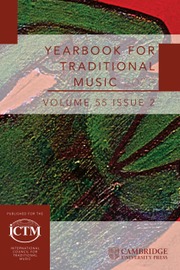No CrossRef data available.
Article contents
Kendhang Gaya Selo: Aesthetic Choice and Musical Exchange among Drummers in Central Java
Published online by Cambridge University Press: 16 September 2024
Abstract
The plucked selo, a three-stringed variation of the cello, in langgam Jawa kroncong music was originally inspired by Javanese gamelan kendhang drumming. By the 1960s, however, Ki Nartosabdho had developed a style of kendhang playing that imitates the selo, often called kendhang gaya selo (selo-style drumming), bringing this musical exchange full circle. Not every piece, however, is considered suitable for this rhythmic treatment. In this article, we examine musical exchanges in a song form known as langgam Jawa between the selo and the Javanese kendhang, and investigate when drummers decide to use kendhang gaya selo in gamelan settings.
Abstrak
Alat musik petik selo dalam langgam Jawa kroncong pada mulanya terinspirasi dari permainan kendhang Jawa. Namun, pada tahun 1960-an, Ki Nartosabdho telah mengembangkan gaya permainan kendhang yang meniru selo, sering disebut kendhang gaya selo yang membawa pertukaran musik ini menjadi pulang pergi. Namun, baik selo kroncong dalam gaya langgam Jawa maupun kendhang gaya selo, berbeda dari praktik yang awalnya diambil dan tidak setiap lagu dianggap cocok untuk perlakuan ritmis ini. Dalam artikel ini kami mengkaji pertukaran musik dalam bentuk lagu yang disebut langgam Jawa antara selo dan kendhang Jawa dan menyelidiki kapan penabuh memutuskan untuk menggunakan kendhang gaya selo.
- Type
- Research Article
- Information
- Copyright
- © The Author(s), 2024. Published by Cambridge University Press on behalf of the International Council for Traditions of Music and Dance
Footnotes
This article has been updated since original publication. A notice detailing the change has also been published.
References
References
A correction has been issued for this article:
Linked content
Please note a has been issued for this article.


